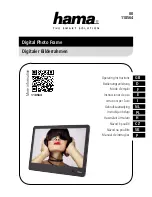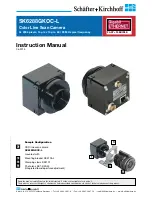
137
Using Your Camera Correctly
e
Read this information and the “Safety Notes” (
➡
P.160), to make sure you use your camera
correctly.
■
Places to Avoid
Do not store or use the camera in the following types
of locations:
h
In the rain or in very humid, dirty or dusty places
h
In direct sunlight or in places subject to extreme
temperature rises, such as in a closed car in
summer
h
Extremely cold places
h
Places with strong vibration
h
Places with smoke or steam
h
Places subject to strong magnetic fields (such as
near motors, transformers or magnets)
h
In contact with chemicals such as pesticides
h
Next to rubber or vinyl products
■
Damage by Water or Sand
The IS-1 can be damaged on the inside and outside
by water and sand. When you are at the beach or
close to water, make sure that the camera is not
damaged by water or sand. Take care not to place the
camera on a wet surface.
■
Damage by Condensation
If the camera is carried from a cold location into a
warm place, water droplets (condensation) may form
on the inside of the camera or on the lens. When this
occurs, turn the camera off and wait an hour before
using the camera. Condensation may also form on the
media. In this event, remove the media and wait a
short time.
■
When the Camera is Not Used or is stored
Periods of Time
If you do not intend to use the camera for a long
period of time, remove the batteries and the media.
■
Cleaning Your Camera
h
Use a blower brush to remove any dust on the lens,
LCD monitor, viewfinder or external AF sensor and
then gently wipe the camera with a soft, dry cloth. If
any soil remains, apply a small amount of lens
cleaning liquid to a piece of FUJIFILM lens cleaning
paper and wipe gently.
h
Do not scratch hard objects against the lens, LCD
monitor or viewfinder.
h
Clean the body of the camera with a soft, dry cloth.
Do not use volatile substances or cleaning products
these items can cause damage.
■
Using the Camera When Traveling
When traveling overseas, do not place your camera in
the check-in baggage. Baggage can be subjected to
violent shocks, and the camera may be damaged
inside or outside.
Power Supply and Batteries
Applicable Batteries
h
In the camera, use AA-size alkaline or Ni-MH
(nickel-metal hydride) rechargeable batteries.
Do not use AA-size manganese or nickel-cadmium
(Ni-Cd) batteries in your IS-1 because the heat
created by the batteries could damage the camera
or cause it not to work.
h
The life of alkaline batteries varies between brands.
The life of batteries you purchase may be shorter
than those provided with the camera.
Notes on the Batteries
Incorrect use of the batteries could cause them to
leak, become hot, ignite or burst. Always observe the
precautions given below.
h
Do not heat the batteries or throw them into a fire.
h
Do not carry or store batteries with metal objects
such as necklaces or hairpins.
h
Do not expose the batteries to water, and keep
batteries from getting wet or stored in moist
locations.
h
Do not attempt to take apart or change the batteries,
including battery casings.
h
Do not subject the batteries to strong impacts.
h
Do not use batteries that are leaking, deformed,
discolored.
h
Do not store batteries in warm or humid places.
h
Keep the batteries out of reach of babies and small
children.
h
Make sure that the battery polarity (
≠
and
–
) is
correct.
h
Do not use new with used batteries. Do not use
charged and discharged batteries together.
h
Do not use different types or brands of batteries at
the same time.
h
If you do not intend to use the camera for a long
period of time, remove the batteries from the
camera. Note if the camera is left with the batteries
removed, the time and date settings are cleared.
h
The batteries feel warm right after being used.
Before removing the batteries, turn the camera off
and wait for the batteries to cool down.
h
Since batteries do not work well in cold weather or
locations, warm the batteries by placing them inside
your garments before use. Batteries do not work well
when cold. They will work again when the
temperature returns to normal.
h
Soil (such as fingerprints) on the battery terminals
makes the batteries charge less reducing the
number of images. Carefully wipe the battery
terminals with a soft dry cloth before loading.
If any liquid at all leaks from the batteries, wipe
the battery compartment thoroughly and then
load new batteries.
If any battery fluid comes into contact with your
hands or clothing, flush the area thoroughly
with water. Note that battery fluid can cause
loss of eyesight if it gets into your eyes. If this
occurs, do not rub your eyes. Flush the fluid
out with clean water and contact your physician
for treatment.
136
136
Accessories Guide
h
xD-Picture Card
Use the following
xD-Picture Card
s:
16MB/32MB/64MB/128MB/256MB/512MB/1GB/2GB
There are two types of
xD-Picture Card
: standard type and Type M (containing “M”
in the model number, such as DPC-M1GB).
IS-1 is compatible with Type M, however they may not be compatible depending on
the device used (Image Memory Card Reader, etc.).
e
Visit the FUJIFILM web site for the latest information on camera accessories.
http://www.fujifilm.com/products/digital/index.html
Accessory availability may vary by country. Please check with your local Fujifilm representative to
confirm product availability.
h
Image Memory Card Reader DPC-R1
The DPC-R1 provides a quick and easy way to transfer images back and forth
between your PC and an image memory card (
xD-Picture Card
and SmartMedia).
The DPC-R1 uses the USB interface for highspeed file transfer.
h
Compatible with
xD-Picture Card
of 16 MB to 512 MB, and SmartMedia of 3.3 V,
4 MB to 128 MB.
h
PC Card Adapter DPC-AD
The PC Card Adapter allows the
xD-Picture Card
and SmartMedia to be used as a
PC Card Standard ATA-compliant (PCMCIA 2.1) PC card (Type
II
).
h
Compatible with
xD-Picture Card
of 16 MB to 512 MB, and SmartMedia of 3.3 V, 2
MB to 128 MB.
h
CompactFlash™ Card Adapter DPC-CF
Loading an
xD-Picture Card
into this adapter allows you to use the card as a
CompactFlash card (Type
I
).
TM
h
AC Power Adapter AC-5VX
Use the AC-5VX when taking pictures or play back images for long periods or when
the IS-1 is connected to a PC.
✽
The shape of the AC power adapter, the plug and power outlet depend on the
country.
h
Soft Case SC-FXS9
This is a special case made of polyester that protects the camera against soil, dust
and minor impacts when it is being carried.
h
Wide Conversion Lens WL-FXS6
This accessory converts the focal length of your lens by 0.8 times (equal to a 30 mm
wide-angle lens) without changing its F-stop value.
h
Wide conversion lens specifications
Magnification:
×
0.8
Lens configuration: 3 lenses in 3 groups
Shooting range (Wide-angle only): Normal approx. 40 cm (1.3 ft.) to infinity/
Macro approx. 10 cm (3.9 ft.) to 3 m (9.8 ft.) /
Super macro approx. 2 cm (0.8 ft.) to 1 m (3.3 ft.)
Dimensions: ø95 mm (3.7 in.)
×
L37.5 mm (1.5 in.)
Weight: approx. 214 g (7.5 oz.)
Accessories: lens caps (front and rear), Lens pouch
Содержание Finepix IS-1
Страница 77: ...153 152 Memo Memo ...
Страница 80: ...159 158 Memo Memo ...
Страница 82: ...163 162 Memo Memo ...















































